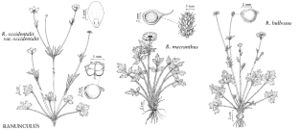Ranunculus occidentalis var. occidentalis
Stems erect to reclining, 1-3(-4) mm thick, hirsute or sometimes glabrous. Basal leaf blades 3-parted or -foliolate, ultimate segments oblong or elliptic to lanceolate or oblanceolate, margins dentate or dentate-lobulate. Flowers: sepals 5, 4-7 mm; petals 5-6, 5-10 × 3-6 mm. Achenes 2.6-3.6(-4) × 1.8-3(-3.2) mm, glabrous or hispid; beak lanceolate, curved, (0.6-)1-1.4 mm.
Phenology: Flowering late winter–spring (Mar–Jun).
Habitat: Grassy slopes of meadows or open woodlands
Elevation: 0-1500 m
Distribution

B.C., Calif., Nev., Oreg., Wash.
Discussion
L. D. Benson (1948) divided Ranunculus occidentalis var. occidentalis into three varieties. The name R. occidentalis var. occidentalis was applied only to plants from Oregon northward, in which leaves are rarely compound and never have lanceolate ultimate segments, and achenes are always glabrous and have beaks over 1 mm. California plants were treated as R. occidentalis var. rattanii (plants with small [5-8 mm] petals from the Coast Ranges) and R. occidentalis var. eisenii (plants with larger petals from the foothills surrounding the Central Valley). Most of those plants from California, however, cannot be distinguished from more northern plants, and forms with small petals are found throughout the range of the variety.
Selected References
None.
